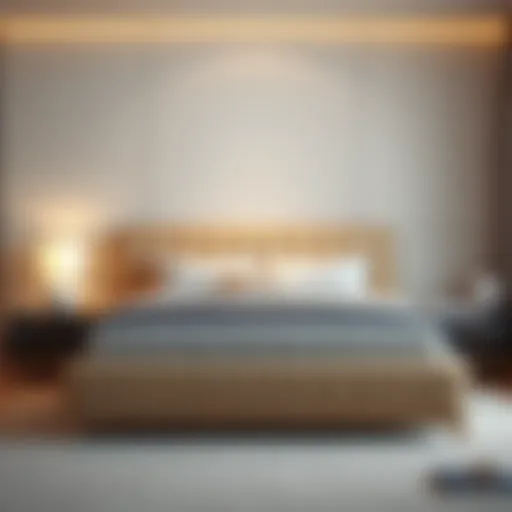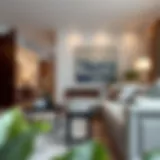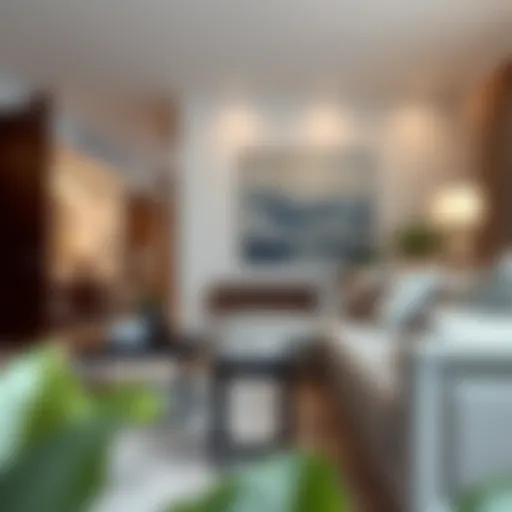The Art and Functionality of Garden Shelves


Intro
Garden shelves, often overlooked in the realm of outdoor design, serve a multitude of purposes that blend functionality with style. Not confined to mere storage solutions, these structures can elevate the look of patios and gardens alike, showcasing plants, tools, and decorative ornaments in a way that invites both admiration and practicality. In this exploration, we delve into how garden shelves can transform outdoor spaces, analyzing various styles, materials, and design inspirations that appeal to a diverse audience.
Whether you are a homeowner looking to spruce up your backyard or a designer aiming for that perfect aesthetic balance, garden shelves can offer innovative solutions that go beyond simple organization. As we plunge deeper into this topic, we’ll also cover maintenance strategies and tips for customization that will help you tailor these shelves to best suit your unique environment.
Furniture Design Styles
Overview of Popular Styles
A wide array of furniture design styles can enhance the beauty of garden shelves. Here are a few that stand out:
- Modern Minimalism: Characterized by clean lines and understated elegance. This style often employs materials like metal and glass, emphasizing functionality without clutter.
- Rustic Charm: Wooden shelves with a weathered finish provide a warm touch. Their natural hues blend seamlessly with greenery, making them ideal for garden settings.
- Industrial Edge: Combining metal and reclaimed wood creates an edgy look. This style caters to urban gardens or patios that embrace a bit of grit and sophistication.
- Bohemian Flair: Think vibrant colors and intricate patterns. Open shelves adorned with a variety of plants and knick-knacks can create a personalized sanctuary.
How to Mix and Match Styles
Blending different design styles can yield unique and enchanting outdoor spaces. Here’s how to achieve this:
- Focus on Similar Materials: Pair a rustic wooden shelf with metal accents to create contrast while maintaining cohesiveness.
- Color Harmony: Ensure that the color palette across different styles complements each other. This can foster visual balance.
- Scale and Proportion: Mix large statement pieces with smaller, detailed shelves to create intrigue and depth.
- Functional Unity: Keep in mind the purpose of each shelf. For instance, a utilitarian shelf for tools can work well alongside a decorative one epitomizing your personal style.
"The beauty of garden shelves lies in their ability to serve purpose and aesthetics simultaneously, encouraging creativity in outdoor design."
Practical Tips for Homeowners
Essential Buying Tips
When venturing to select garden shelves, consider the following:
- Material Durability: Opt for weather-resistant materials, especially if your area experiences seasonal changes. Treated wood, metal, and high-grade plastics are sound choices.
- Size Matters: Assess your space and choose shelves that suit the scale of your gardening needs and aesthetic desire. Small spaces benefit from vertical shelving, while larger areas can accommodate more expansive designs.
- Design Functionality: Think about how you intend to use the shelves. Are they merely for display or will they also store gardening essentials?
Maintenance and Care Guidelines
To ensure your garden shelves remain in top-notch condition, follow these pointers:
- Regular Cleaning: Dust and dirt can accumulate, so periodic cleaning is essential. A damp cloth often suffices for quick maintenance.
- Weather Protection: For wooden shelves, applying a sealant can deter moisture damage. For metal, consider rustproofing solutions.
- Inspect for Damage: Regularly check for wear and tear. Early detection of cracks or rust can help you save time and resources in the long run.
By considering design styles and maintaining your garden shelves properly, you can create a harmonious blend of elegance and practicality in your outdoor spaces. Following the tips outlined in this guide will arm you with the knowledge to select, style, and sustain these essential components of architectural beauty. For deeper insights into garden design, consult resources such as Wikipedia, Britannica, or community discussions on platforms like Reddit.
The Role of Garden Shelves in Outdoor Design
Garden shelves are not merely an aesthetic addition to your outdoor space; they serve as functional elements that harmonize beauty with practicality. In outdoor design, these structures play multiple roles—from providing storage solutions to enhancing the visual appeal of gardens, patios, and balconies. By allocating a specific segment of space for organization, garden shelves encourage efficiency and creativity within garden layouts.
The importance of garden shelves lies in their versatility. They come in various designs and materials, catering to a range of personal styles and environmental conditions. This adaptability allows them to fit seamlessly into various landscapes, whether it’s a modern urban garden or a rustic country setting. These shelves can act as stage for flowers, herbs, and decorative objects, creating visual focal points that draw the eye and enliven the space.
When one contemplates outdoor design, elements like color, texture, and arrangement usually take center stage. However, garden shelves provide several functional benefits beyond enhancing aesthetics. They optimize space by allowing gardeners to utilize vertical areas, making room for additional plants without compromising ground space. This method of vertical gardening not only elevates the garden's design but also optimizes sunlight exposure for plants that might otherwise be overshadowed.
Furthermore, it invites organization and reduces clutter in gardeners' spaces. Tools, pots, and gardening supplies can be stored on these shelves, ensuring that the items remain accessible yet neatly contained. The convenience of readily available tools can make or break a gardening session, and garden shelves deliver on this necessity.
"Utilizing vertical areas can give small gardens a much-needed breath of fresh air, making them feel larger and more inviting."
From a design perspective, selecting and placing garden shelves invites thoughtful consideration. The right size, color, and structure can complement the garden’s theme and contribute to a unified atmosphere. More than a mere functional callback, the design of garden shelves can reflect personal style—rustic wood adds warmth, while sleek metal can lend a contemporary flair.
In a world where outdoor living spaces are becoming an extension of the home, garden shelves facilitate that connection. They allow for creativity—whether it's through hand-painting wood, mixing materials, or installing solar lights for ambience. As homeowners increasingly seek outdoor retreats, the role of garden shelves in outdoor design only grows in significance.
Understanding Different Types of Garden Shelves
When it comes to enhancing outdoor spaces, garden shelves aren't just decorative; they’re functional tools that can transform the way we use our gardens. Different types of garden shelves serve distinct purposes, catering to the unique needs and aesthetics of each space. Understanding these types is essential for homeowners, decorators, and DIY enthusiasts seeking to maximize both beauty and utility in their garden designs. By exploring the diverse configurations of garden shelves, you can discover the right fit for your setting while ensuring an organized and visually pleasing outdoor area.
Vertical Shelves for Space Efficiency
Vertical shelves are a game-changer for small patios or gardens where every square inch counts. Unlike regular shelving, this design utilizes upward space, creating a sense of height in a compact area. Imagine a narrow wall or corner that previously collected dust and debris; with the addition of vertical shelves, it transforms into a vibrant display for herbs, succulents, or seasonal flowers.
- Maximized Use of Space: The vertical plane is often underutilized. By going upwards, you reduce clutter on the ground and make small spaces feel larger. This is essential for urban gardens where building codes or space restrictions limit options.
- Easier Maintenance: Vertical structures allow easy access during watering or pruning. Rather than bending down for pots on the ground, simply step back and tend your plants from a comfortable height.
- Creative Display: These shelves invite creativity. Use varying heights, mix textures, and incorporate colors that resonate with your taste. You might combine clay pots with glass vases for an eclectic but harmonious look.
Such shelving can be made of wood or metal, depending on the garden's overall theme. With a little imagination and planning, vertical shelves can transform an average garden into a stunning visual masterpiece.
Tiered Shelving Options
Tiered shelves offer a unique way to showcase a variety of plants and decorations by providing multiple levels for display. This design works particularly well for herbs, flowers, or ornamental items, allowing sunlight to reach each level adequately.
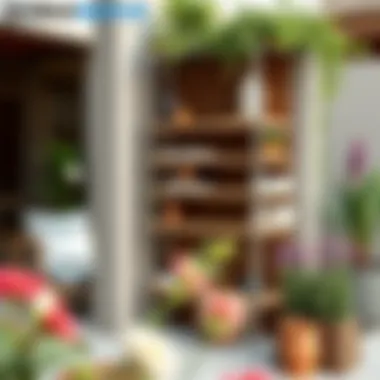
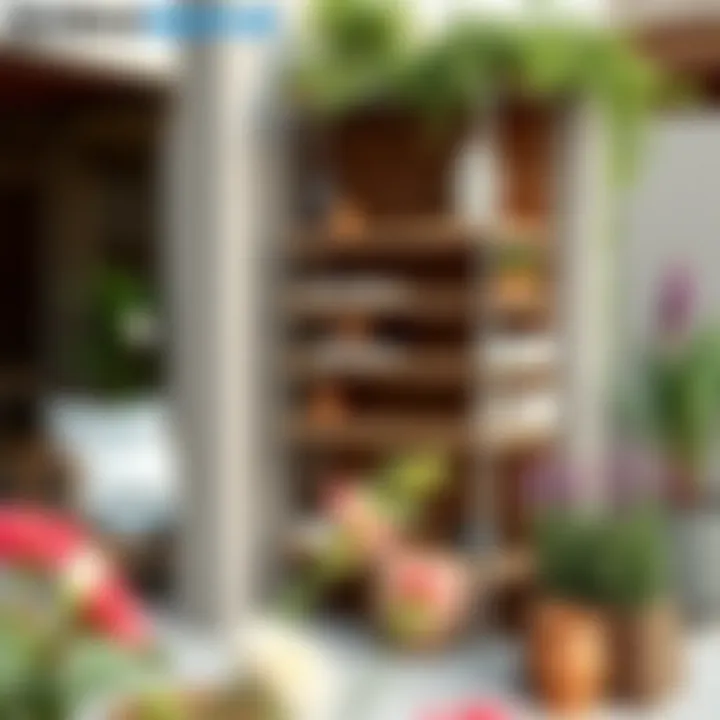
- Layered Visuals: The tiered format creates depth in your display. Lower plants benefit from the shadowing effect of taller plants, promoting healthy growth. This graduated arrangement invites the eye to traverse from the lowest to the highest tier seamlessly.
- Functional Arrangement: One can organize plants based on their growth patterns or sunlight needs. For instance, tall sunflowers might take the upper tiers, while delicate herbs sit below, receiving just the right amount of light.
- Adaptability: These shelves can be easily adapted to various themes, whether rustic, modern, or tropical. You could stain wood for a classic look or paint metal for a contemporary feel.
In practical terms, tiered shelves are often simple to construct and can even be DIY projects, blending functionality with creativity. The benefits extend far and wide, appealing to both novice gardeners and seasoned horticulturists alike.
Floating Shelves and Their Aesthetic Benefits
Floating shelves have a certain charm that adds a minimalist touch to any garden. They create an illusion of space while offering versatile display options without overwhelming an area.
- Visual Lightness: The lack of visible brackets gives floating shelves a sleek appearance. This can be particularly beneficial in smaller gardens, where heavy structures can dominate the space.
- Versatility in Design: Floating shelves can be used to display anything from plants to garden tools or decorations. The flexibility of their application makes them a perfect choice for transforming dead wall space into something practical yet beautiful.
- Customization Potential: You can choose any size or material that matches your home’s architecture. Whether you go for rustic reclaimed wood or modern lacquered finishes, they can be made to fit any decor style.
Floating shelves offer both beauty and function. They can be mixed and matched with other types of shelves to create a coherent and captivating design.
"Garden shelves are not merely functional elements; they are statements of style in the outdoor realm, merging utility with artistic expression."
In summary, exploring the various types of garden shelves allows homeowners and designers alike to create visually stunning and highly functional outdoor environments. By selecting the right configuration—be it vertical, tiered, or floating—you can ensure that your garden holds both beauty and practicality, tailored perfectly to your needs and preferences.
Materials Commonly Used in Garden Shelf Construction
When it comes to garden shelves, the choice of materials plays an essential role in shaping their functionality and aesthetic appeal. Each material brings its own advantages and sets the tone for the garden space they occupy. Understanding the characteristics of wood, metal, and plastic allows homeowners and designers alike to make educated decisions that enhance their outdoor environments. This section highlights the significance of material selection, discussing various benefits and considerations that ought to be kept in mind when navigating through options for garden shelves.
Wood: A Classic Choice
Wood has stood the test of time as a favorite for garden shelf construction, impressive not only for its visual warmth but also for its versatility. Wooden garden shelves can come in different types, ranging from sturdy cedar to the more affordable pine. This variety allows for tailored solutions based on functional needs and personal style preferences.
One of the primary advantages of wood is its natural ability to blend seamlessly with various styles of landscaping. Whether set against a backdrop of manicured hedges or mingling with wildflowers, wooden shelves offer a rustic charm that’s hard to replicate. However, it’s important to factor in that wood will require regular maintenance, especially when exposed to the elements; treating it with specific oils or sealants can enhance longevity.
Moreover, while many might think of wood as a renewable resource, it is vital to source it sustainably to minimize ecological impact. Always look for certifications like the Forest Stewardship Council (FSC) label, ensuring the wood is harvested responsibly.
Metal Shelves: Durability and Modern Design
Metal shelves have gained traction among those seeking a more contemporary aesthetic. Stainless steel and aluminum are common choices that not only bring a modern edge but also boast remarkable durability. These materials are less likely to warp or succumb to rot, making them ideal for areas with harsh climates or moisture exposure.
"Investing in metal garden shelves means investing in longevity, which is perfect for those who want to make a statement while minimizing upkeep."
However, metal can present its challenges—rust is a concern unless proper coatings are applied. Manufacturers often incorporate technology that combats corrosion, meaning you can find options that hold up beautifully for seasons on end.
Additionally, metal’s adaptability allows for the incorporation of sleek designs. From intricate patterns to minimalist frames, they cater to both decorative and practical needs. The usage of powder-coated finishes can also introduce a splash of color, enhancing garden character.
Plastic Alternatives: Practicality in Various Climates
While wood and metal each have unique qualities, plastic shelves present a practical alternative that’s hard to ignore. Modern advancements have improved the durability of plastics significantly, allowing for lightweight yet strong options that resist fading and cracking under various environmental pressures.
The beauty of selecting plastic garden shelves lies in their ease of maintenance. They are waterproof, often UV-resistant, and can withstand the whims of wet or sunny conditions without deterioration. Furthermore, plastic comes in a myriad of designs and colors, providing myriad options to suit diverse tastes and gardens.
However, critics might argue about the aesthetic limitations of plastic as opposed to the organic feel of wood or metal. Yet, this doesn’t mean one has to compromise on style; many suppliers offer faux finishes that mimic wood patina or painted metal, ensuring you don’t sacrifice beauty for practicality.
When contemplating garden shelf options, the materials chosen will ultimately dictate not only the shelf's style but also its functionality and overall longevity in the outdoor space. Choosing wisely means enhancing the garden's charm while ensuring these structures stand the test of time. For more information on material types and their benefit, you might find these resources helpful: Wikipedia and Britannica.
Design Considerations for Garden Shelves
Designing garden shelves might appear as a simple task, yet it encompasses a variety of aspects that can profoundly influence their functionality and aesthetic appeal. Often, people assume that any shelf will do, but the importance of thoughtful design cannot be overstated. When considering size, configuration, and harmonization with outdoor spaces, these elements play a pivotal role in creating a cohesive and functional garden environment. Moreover, it’s essential to keep practical placement in mind, ensuring that these shelves serve their purpose without disrupting the natural flow of the garden.
Choosing the Right Size and Configuration
When selecting garden shelves, the size and configuration are crucial. A shelf that's too large can overshadow your garden's charm, while a tiny shelf can get lost among blooms and plants. To choose the right size, consider the space you’re working with. Are you working in a compact balcony garden, or do you have an extensive backyard? In tighter spots, think about vertical shelves to maximize space utilization. They take up less ground space while offering ample area to showcase plants or tools. For expansive areas, tiered configurations allow for a dynamic display, inviting interest as you look from various angles.
Some practical sizes to keep in mind include:
- Narrow shelves: Ideal for herbs or succulents, allowing easy access and tending.
- Medium-sized shelves: Suitable for displaying larger pots or decorative items.
- Wide shelves: Perfect for integrating multiple elements, from garden tools to unique decorations.
A well-thought configuration can also aid in maintaining organization. Design your shelves with thoughtful spacing and layouts in mind; remember, plants of different heights can create visual layers but require attention to ensure sunlight and water reach them adequately.
Aesthetic Harmonization with Outdoor Spaces
Aesthetic harmony is where garden shelves can truly shine or flop based on how they fit within the broader garden theme. Whether one’s garden reflects a rustic charm or a sleek modern vibe, the choice of shelving materials and colors should echo that ambiance.
Using natural wood in a garden full of blooms can provide warmth and a sense of earthiness. Conversely, metal shelves can offer a chic, minimalist look, complementing contemporary garden designs. The choice could also be influenced by your outdoor furniture or surrounding structures, ensuring a cohesive visual narrative.
Another worthwhile consideration is the color palette. Earthy tones can blend beautifully while bright colors can make for an interesting contrast, drawing eyes toward the shelves rather than leaving them unnoticed.
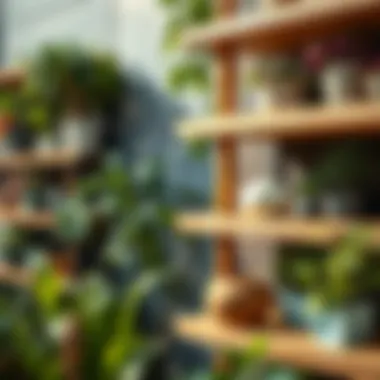
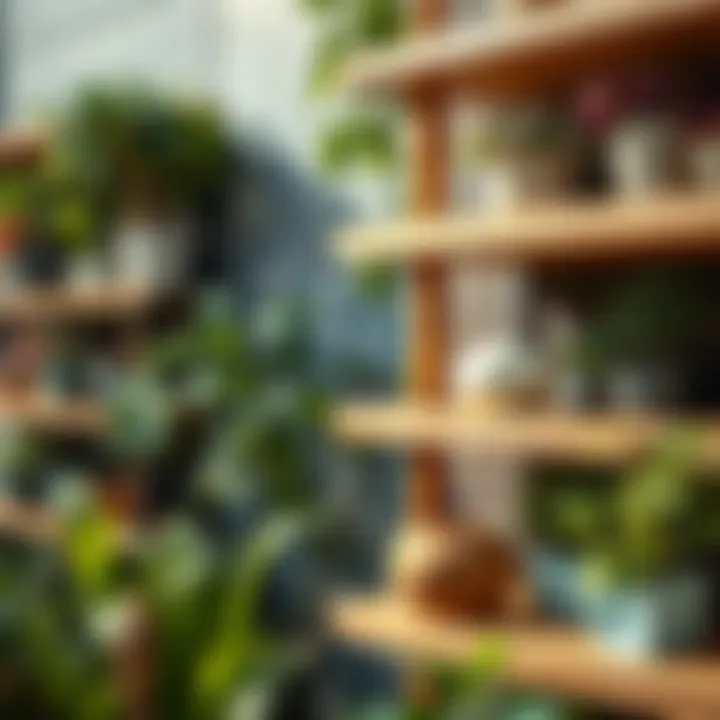
Ultimately, aligning your shelves’ aesthetics with the overall outdoor space elevates the garden experience and creates a place where every element feels intentional yet integrated.
Functional Placement in Gardens
Placement is the name of the game when it comes to the utility of garden shelves. Their location should provide easy access for gardeners while also considering the specific needs of the plants or items they will display. Placing shelves in areas that receive adequate sunlight can make a remarkable difference for light-loving plants, while shaded areas can be perfect for delicate species that thrive in lower light.
Think strategically about sectors of your garden. For instance, a corner can serve as a great spot for vertical shelves, taking up less space while improving accessibility. Moreover, placing shelves near lounges or seating areas can enhance your yard’s usability, allowing you to admire plants or decorative pieces without the hassle of strolling back and forth across the garden.
A thoughtful approach can also include layering the shelves. By placing larger, bulkier items at the base and smaller accents above them, one not only ensures ease of access but also adds dimension to the shelf setup.
In summary, keeping an eye on size, configuration, aesthetic integration, and optimal placement can significantly amplify the functionality and charm of garden shelves, making them integral to outdoor design.
The Practical Use of Garden Shelves
Garden shelves do more than merely occupy space in your yard or garden; they articulate a deeper purpose within any outdoor design. These functional structures bridge the gap between aesthetics and utility, helping homeowners to optimize their gardening experience and outdoor ambiance. When used wisely, they can significantly enhance organization, accessibility, and creativity in various garden settings.
Storage Solutions for Garden Tools
One of the most prominent functions of garden shelves is their ability to organize and store tools effectively. Imagine a robust shelf adorned with a variety of hangers, hooks, and bins specifically designed to hold everything from trowels to pruning shears. This careful arrangement not only keeps the tools within arm's reach but also prolongs their lifespan by minimizing wear and tear.
Benefits of utilizing garden shelves for tools include:
- Accessibility: No more rummaging through cluttered sheds or garages. Everything has a designated spot, allowing for quick and easy access.
- Space Management: Vertical shelves or tiered designs take advantage of vertical space, freeing up ground area for other garden activities.
- Enhanced visibility: Proper storage makes it easy to see what you have on hand, preventing duplicate purchases of tools that might already be gathering dust.
By using shelves as a dedicated tool station, gardeners can transition from chaos to order without much fuss, providing a stress-free gardening experience.
Display Areas for Plants and Decor
Not only are garden shelves functional, but they also serve as charming display areas for plants and decorative items. When arranged thoughtfully, shelves can transform a simple patio into a vibrant showcase of greenery and artistic expression. Consider a floating shelf adorned with colorful pots of fragrant herbs or succulents; it adds life and texture while creating impressions of depth in smaller spaces.
Key points to remember while designing displays on shelves include:
- Layering for Depth: Using different shelf heights and sizes can create a layered effect, making the arrangement visually interesting. Taller plants can be placed at the back, while smaller ones can grace the front.
- Seasonal Rotations: A shelf allows the possibility of changing displays throughout the seasons. Swap out summer blooms for fall foliage to keep the look fresh and engaging.
- Incorporating Decor: Don't shy away from adding personal touches such as candles, stones, or decorative vases. These elements provide character and can reflect your personality or thematic design.
By carefully considering the arrangement and content displayed, owners can turn any shelf into a work of art.
Employing Shelves for Vertical Gardens
Vertical gardening is a trend that has been gaining traction, particularly in urban settings where space often comes at a premium. Garden shelves can facilitate this trend by providing a structured support system for climbing plants, herbs, and even vegetables. Vertical gardens not only save space but also enhance air circulation and sunlight exposure, which are pivotal for the healthy growth of patio plants.
Exploring this method, gardeners can:
- Maximize Small Areas: Even a balcony or a narrow pathway can become a lush green space with the right shelving configuration.
- Diverse Planting Options: From trailing plants like ivy to vertical herb gardens, shelves allow for a variety of planting choices, providing versatility in gardening.
- Aesthetic Appeal: An upward flourish of greens brings not just functionality but also charm to any outdoor space, creating a mini oasis.
In summary, the incorporation of garden shelves into practical uses opens doors to numerous possibilities for organization, decoration, and cultivation. The essence of using these shelves lies in creativity, personalization, and the ability to adapt them to meet specific gardening needs.
DIY and Customization Opportunities
The world of garden shelves is not just about purchasing premade structures; it's a canvas for creativity and personal expression. Customizing your garden shelves through DIY projects is not only infused with your own touch but also offers several benefits that elevate both functionality and style in outdoor spaces.
Creating your own garden shelf allows you to tailor the design to fit the specific needs of your outdoor area. You get to decide on dimensions, colors, and materials that complement the existing decor of your garden. This personalization means your shelves won't just serve a practical purpose, but they'll also be an extension of your personality—showing off your unique sense of style.
Tailoring Shelf Designs to Fit Personal Aesthetics
When diving into the creation of custom garden shelves, it’s vital to think about how the shelves will harmonize with your garden's overall aesthetics. Here are a few aspects to consider:
- Color Schemes: Choose paints or stains that either blend with your garden’s palette or create striking contrasts. Soft earth tones tend to work well in natural settings, while bold colors can make a vibrant statement.
- Material Choices: Each material tells a story. For instance, reclaimed wood carries a rustic charm, while metal shelves infuse a modern touch. Think about what narrative you want to convey through your shelves.
- Functionality: Keep in mind what you plan to display or store. For example, open shelves might suit plants that require sunlight, while deeper, more enclosed shelves are suitable for tools or decorative items.
This approach not only enhances the visual appeal of your garden but also fosters an emotional attachment, making your outdoor space feel more like home.
Repurposing Old Furniture into Garden Shelves
A clever strategy to merge sustainability with customization is to repurpose old furniture into striking garden shelves. This practice not only minimizes waste but also allows you to incorporate meaningful items from your home into your garden.
Consider the following suggestions when repurposing furniture:
- Suitability: Select furniture that can withstand outdoor conditions. Items made from solid hardwood or treated metal tend to hold up better against the elements.
- Modification: Depending on the piece, you may need to make some tweaks. A wooden dresser can become multiple levels of shelving with some basic reconfiguration, while a ladder can serve as a whimsical vertical shelf for pots.
- Personalization: Paint or stencil the furniture to reflect your garden’s theme or your personal taste. Old pieces can come alive with a fresh coat of paint or by adding embellishments that bring out your style.
Repurposing old furniture not only keeps things out of landfills but also cultivates an atmosphere rich with personal history. This connection makes the garden not just a place for plants but also a display of memories and creativity.


In summary, DIY and customization opportunities with garden shelves allow individuals to express individuality while engaging in sustainable practices. By considering personal aesthetics and repurposing existing materials, one can create unique outdoor arrangements that serve practical purposes and appeal to the eye.
Maintenance and Care of Garden Shelves
In the realm of horticulture and outdoor design, garden shelves play an essential role. However, their beauty and functionality can be dramatically diminished without proper maintenance and care. Taking the time to regularly maintain these structures not only preserves their visual appeal but also extends their lifespan, ensuring continued usefulness in your outdoor spaces.
Engaging in a few simple maintenance routines can prevent more severe issues later on, saving time and money in the long run. Furthermore, the attention you give these elements reflects on the overall aesthetic of your garden, showcasing a space that is both well-organized and visually inviting.
Seasonal Maintenance Routines
Regular seasonal maintenance is crucial for keeping garden shelves in prime condition. Each season presents its own unique challenges and tasks that should not be neglected.
- Spring: This is the time to inspect your shelves for winter wear and tear. Remove any debris, leaves, or dust accumulated over the cold months. Check for any wobbling or loose screws, and tighten or replace as necessary. If your shelves are wooden, a light sanding may be in order along with a fresh coat of weatherproof sealant to guard against moisture.
- Summer: During the hot months, ensure that the shelves are not under too much direct sunlight, which could cause warping or fading, specifically in synthetic materials. If you notice any discoloration or damage, consider relocating the shelves or adding shade with awnings or parasols.
- Autumn: As the leaves begin to fall, be on the lookout for debris accumulation. This can lead to moisture retention, potentially rotting wood. A thorough cleaning and inspection will do wonders; it’s also the best time to reapply any protective treatments.
- Winter: Depending on your climate, the winter can be brutal. If you expect heavy snow or ice, it may be wise to disassemble or cover your shelves to protect them from the elements. Consider bringing more vulnerable items inside to prevent damage.
Preventing Weather-related Damage
Weather can be unkind to garden shelves, particularly those made from wood or metal. The elements can gradually erode structures without proper care. Here are some steps to consider for stave off damage:
- Choose Weather-resistant Materials: When selecting or maintaining garden shelves, consider materials that already offer weather resistance, like treated wood, galvanized metal, or high-density polyethylene.
- Apply Protective Coatings: A good, quality sealant can work wonders on wooden shelves. It acts as a barrier against moisture, UV rays, and temperature fluctuations. Be vigilant with reapplications based on the specific product's guidelines.
- Optimize Placement: Position your shelves in areas that avoid the brunt of harsh weather. If heavy winds or constant rain is expected, a sheltered spot under overhanging trees or near walls can provide a buffer.
Restoration Techniques for Long-term Use
Over time, even the best-maintained garden shelves may require restoration to maintain their functionality and appearance. Here are some techniques to keep in mind:
- Wooden Shelves: If you have wooden shelves that are starting to show signs of wear, sand down any rough patches and apply a new coat of wood stain or paint. This adds an extra layer of protection while reviving the original color. In some cases, you may need to replace damaged planks entirely.
- Metal Shelves: Rust can be a pesky problem for metal shelves. Start by scrubbing off any rust with a wire brush or sandpaper. Follow up with a rust-inhibiting primer and a fresh coat of paint designed for metal outdoor use. This not only helps to restore them but guards against future rusting.
- Plastic Shelves: Although generally less prone to damage, plastic can fade or become brittle over time. Clean with a mild soap and water to refresh the surface, and for faded colors, consider specialized plastic restorers or sprays that can rejuvenate the hue.
"Regular upkeep is the heartbeat of a vibrant garden. Without it, even the finest shelves could lose their charm in the blink of an eye."
With these maintenance and care guidelines, garden shelves can not only stand the test of time but also contribute to an ongoing dialogue of beauty and utility in your outdoor spaces.
Integrating Technology with Garden Shelves
Integrating technology into garden shelves is not just a trend; it’s becoming an essential part of modern outdoor living. In a world where convenience meets creativity, merging technical solutions with garden shelving elevates functionality and aesthetics. This section explores the importance of this integration and how it enhances the gardening experience for anyone from novice hobbyists to seasoned gardeners.
Technological enhancements in garden shelving introduce numerous benefits. For starters, smart gardening solutions can automate the care of plants and optimize space usage. They make managing your outdoor area easier and provide insightful data that helps improve gardening practices.
Smart Gardening Solutions
Smart gardening solutions come equipped with various features that dovetail beautifully with garden shelves. Imagine being alerted via your smartphone that your plants need watering or that the sunshine is optimal for growth at certain times. Sensors nowadays can monitor soil moisture levels, temperature, and even light exposure—providing real-time feedback.
- Remote monitoring and control: You can connect your gardening shelves to a smart home system. This allows for monitoring garden conditions from anywhere.
- Automated irrigation systems: Some shelves can house integrated drip irrigation systems. This ensures that plants get the right amount of water, reducing plant stress and promoting growth.
- Data analytics: By measuring how well different plants grow under various conditions, gardeners can fine-tune their methods, leading to higher yields and healthier plants.
This approach not only saves time and labor but also helps in being judicious with resources such as water and electricity.
Utilizing Solar Lighting for Enhanced Ambiance
Bringing solar lighting into the mix further enhances the appeal of garden shelves. Solar lights can be mounted on or around shelves, creating an enchanting atmosphere that allows gardens to come alive at dusk.
The advantages of using solar lighting include:
- Energy-efficient: Solar lights don’t add to the electricity bill. They harness the sun, which is free.
- Safety and visibility: They brighten up pathways and outdoor rooms, making the areas around shelves safer and more inviting after dark.
- Aesthetic appeal: Different designs of solar lights, such as decorative lanterns or sleek modern fixtures, can complement the aesthetics of garden shelves. The right lighting subtly highlights the beauty of plants, making your garden a welcoming space.
"Integrating tech into gardening is like adding a cherry on top of a sundae; it’s not necessary, but it sure makes things sweeter."
As we look toward the future, the integration of technology with garden shelves will likely continue to evolve. Whether one opts for smart sensors, automated watering, or solar lighting, they’re improving not only the efficiency and utility of their garden space but also enhancing the beauty of their outdoor environment. This interplay of technology and nature creates a seamless experience that any gardener can appreciate.
The Future of Garden Shelves in Home Design
The concept of garden shelves is rapidly evolving, reflecting broader trends in outdoor design and the increasing need for functionality alongside aesthetic appeal. In modern home design, garden shelves are not merely decorative items placed in yards; they are functional masterpieces that harmoniously blend with the environment, contribute to sustainability goals, and enhance the outdoor living experience.
Trends Shaping Garden Shelf Innovations
In recent years, several trends have emerged in the world of garden shelves that highlight their importance in effective outdoor design.
- Modular Designs: Homeowners are increasingly opting for modular shelving systems that can be easily customized according to space and usage needs. This flexibility allows for personal expression and practicality.
- Smart Integration: With technology becoming ubiquitous, garden shelves are also seeing integrations with smart home features. Shelves equipped with sensors that monitor plant health or lighting systems can enhance the overall gardening experience. These innovations bring together the ease of technology and the satisfaction of nurturing plants in a personalized environment.
- Vertical Gardens: Especially in urban settings where space is at a premium, vertical gardening solutions are becoming fashionably functional. Shelves designed to hold a variety of plants vertically make gardening accessible in otherwise cramped spaces. Gone are the days when a large garden was a prerequisite for cultivating plants.
"Creating a personalized outdoor experience through innovative garden shelf designs not only beautifies a space but also makes gardening more accessible and practical for everyone."
Sustainability in Garden Shelf Practices
As society becomes increasingly aware of environmental concerns, sustainability plays a crucial role in the design and function of garden shelves. Homeowners and designers alike are recognizing that the materials and techniques used in constructing these shelves can either contribute to or mitigate environmental issues.
- Eco-Friendly Materials: A growing trend involves using sustainable materials such as reclaimed wood and recycled metals. These choices not only lessen the carbon footprint but also add character and a story to the garden shelves, appealing to eco-conscious consumers.
- Water Conservation Techniques: Garden shelves can be designed with rainwater collection systems or integrated drip irrigation methods, promoting efficient water use. These systems help gardens thrive while prioritizing water efficiency, vital in areas experiencing drought.
- Native Plant Use: To further cement their role in sustainable gardening practices, garden shelves are increasingly being utilized to showcase native plant species. These plants are often hardier and require less maintenance, helping further reduce resource usage.
With the trends shaping garden shelf innovations along with a commitment to sustainability, the future of garden shelves in home design promises a blend of form and function. As they become more integral to outdoor spaces, understanding their role encourages creativity and responsibility in how we design and utilize our environments.







